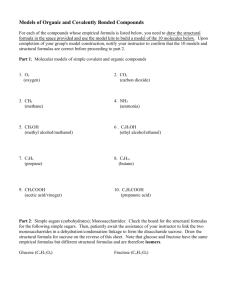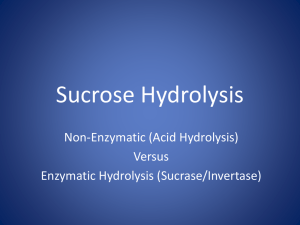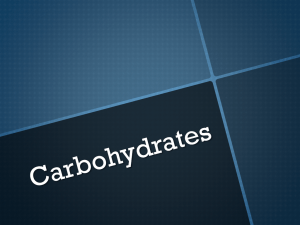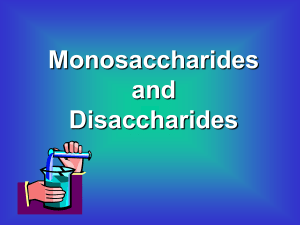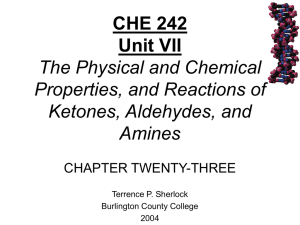here
advertisement
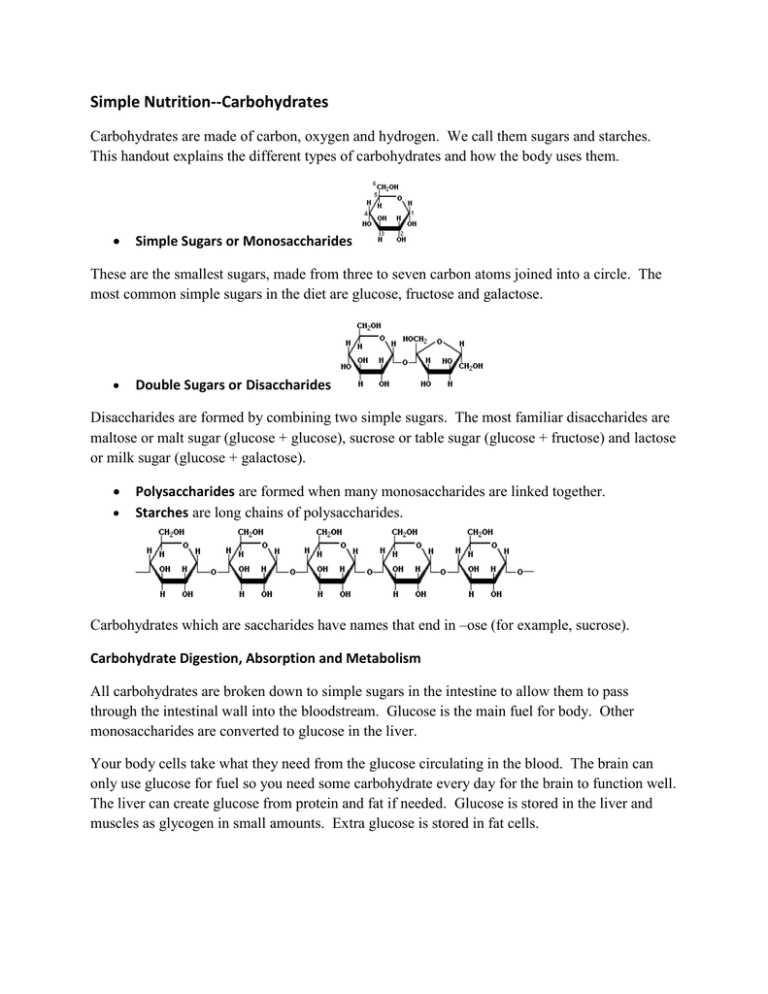
Simple Nutrition--Carbohydrates Carbohydrates are made of carbon, oxygen and hydrogen. We call them sugars and starches. This handout explains the different types of carbohydrates and how the body uses them. Simple Sugars or Monosaccharides These are the smallest sugars, made from three to seven carbon atoms joined into a circle. The most common simple sugars in the diet are glucose, fructose and galactose. Double Sugars or Disaccharides Disaccharides are formed by combining two simple sugars. The most familiar disaccharides are maltose or malt sugar (glucose + glucose), sucrose or table sugar (glucose + fructose) and lactose or milk sugar (glucose + galactose). Polysaccharides are formed when many monosaccharides are linked together. Starches are long chains of polysaccharides. Carbohydrates which are saccharides have names that end in –ose (for example, sucrose). Carbohydrate Digestion, Absorption and Metabolism All carbohydrates are broken down to simple sugars in the intestine to allow them to pass through the intestinal wall into the bloodstream. Glucose is the main fuel for body. Other monosaccharides are converted to glucose in the liver. Your body cells take what they need from the glucose circulating in the blood. The brain can only use glucose for fuel so you need some carbohydrate every day for the brain to function well. The liver can create glucose from protein and fat if needed. Glucose is stored in the liver and muscles as glycogen in small amounts. Extra glucose is stored in fat cells. Simple Nutrition—Nutritive Sweeteners Nutritive sweeteners contain carbohydrate and provide calories. Sweeteners or sugars can be naturally present in the food or added during manufacturing, cooking or at the table. Mono and disaccharides provide 4 calories/gram. Polyols contain 2 calories/gram; these sugars have a different chemical structure than the saccharides. Polyols are identified by a name ending is –ol such as sorbitol, mannitol, xylitol; they are often used in “sugar free” gums and candies. Some people will have gastrointestinal side effects if they eat too many polyols at once. Agave nectar contains fructose, glucose and fructans (an oligosaccharide of glucose and fructose) and provides 3 calories/gram. “Sugars” found in food include glucose, fructose, galactose, sucrose, and maltose. Corn-based sweeteners such as corn syrup or high fructose corn syrup are made from corn, and are a combination of glucose and fructose. The 2010 Dietary Guidelines for Americans indicates that the body metabolizes natural and added sugars the same way. In general, foods high in added sugars tend to be higher in calories. Numerous agencies recommend limiting total “added sugar” consumption. The American Heart Association advises women limit added sugars to 100 calories/day (about 6 teaspoons) and men limit their intake to 150 calories/day (about 9 teaspoons). Top food sources are soda/energy/sports drinks, fruit drinks, desserts and candy. Food labels do not separate natural sugars from added sugars; the term “sugar” refers to all simple sugars present in the food. The only way to identify added sugars is to read the ingredient listing, looking for all the words that might indicate a sugar. Health concerns Most scientists believe that obesity and associated diseases are due to increased total sugar of all types which increased dramatically from the 1970’s to the 2000’s. Since 2000, there has been a decline in sugar intake, but more is needed. High Fructose Corn Syrup (HFCS) is a combination of fructose and glucose. As of 2012, studies found little evidence that HFCS is different from sucrose in how the body uses it and health effects. The studies so far have been small and short so more research is advised. High fructose intake does increase uric acid levels which can be a concern for people diagnosed with gout. HFCS is used by food manufacturers instead of sugar (sucrose) because it is easier to use, less expensive and more reliably available than sugar. The process to produce HFCS commercially was developed in the mid 1970’s, and use increased rapidly.
